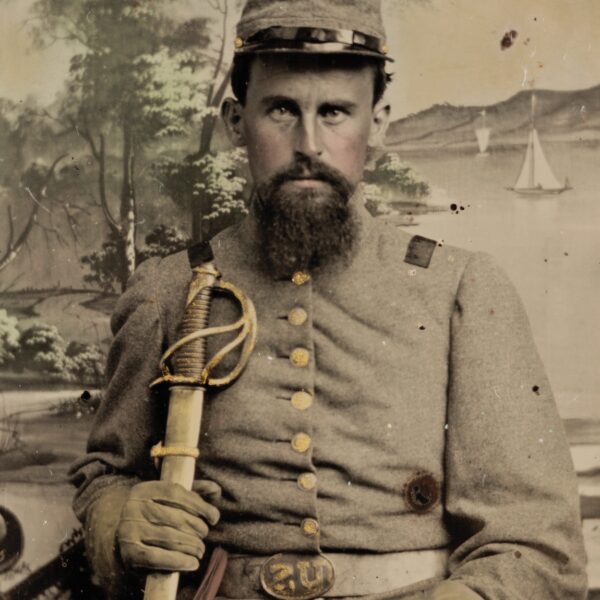
“Spare Cartridges” by Alfred R. Waud
In considering the vast literature on combat in the Civil War, one is hard-pressed to limit a selection of the best works to a short list. Understanding the nature of that combat requires imposing coherence on the bloody, often chaotic character of war. Writing combat history can be one of the most significant challenges any historian faces; it requires sifting through complex and conflicting pieces of evidence, while accounting for bias and shifting and flawed perspectives in trying to capture combat’s essence. Achieving anything like a universal understanding of Civil War combat would be impossible, as individual experiences in battle varied, like in any war. Some soldiers saw little or no action and lived through the war in relative safety, out of harm’s way or consigned to tedium. Others fought repeatedly, surviving unimaginable suffering in campaign after campaign, and witnessing mind-numbing scenes of carnage and tragedy. Something many combat veterans agreed on was that combat was hardly romantic or glorious, and that the first taste of battle often shattered their illusions.
Civil War combat was usually conducted in the line-of-battle formation, the customary stance for a unit under fire. Those Napoleonic linear tactics maximized officers’ ability to control and maneuver their commands and enabled armies to concentrate and coordinate fire on enemy formations. As such, it required discipline and technical expertise achieved through extensive drill, as promulgated in military manuals and practiced incessantly. On the march, Civil War units typically moved in column formation for efficiency’s sake, which also required expertise and drill to manage effectively. Combat also encompassed the use of pickets and skirmishers, assaults, fighting in fortifications, sharpshooting, the bayonet, and hand-to-hand fighting. Civil War soldiers had to master their doubts and fears, coming to terms with the possibility of death or injury before every engagement, as well as the physical, emotional, and psychological toll of their experiences. Above all else, combat was not simply killing; it was organized violence, though at times unrestrained, but undertaken in pursuit of some larger purpose or objective. Any work delving into the essence of Civil War combat ought to at least touch on many of these themes—as each of the following books does magnificently.
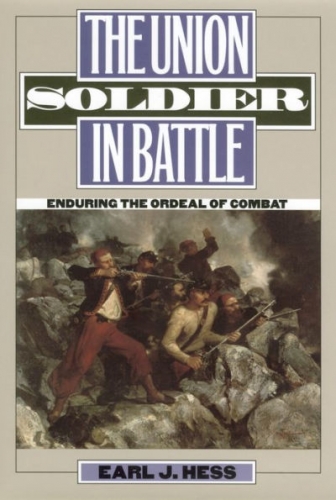
THE UNION SOLDIER IN BATTLE: ENDURING THE ORDEAL OF COMBAT
(UNIVERSITY PRESS OF KANSAS, 1997)
BY EARL J. HESS
Earl Hess has a reputation as the preeminent historian of Civil War combat for good reason; his books on the rifle musket, infantry tactics, logistics, fortifications, and a host of operations and campaigns are indispensable contributions to the field. His Union Soldier in Battle: Enduring the Ordeal of Combatexamines how Civil War soldiers confronted the experience of combat and so adapted their expectations and behaviors. Hess humanizes the Union soldier in remarkably sensitive ways, portraying Billy Yank as both pragmatic, even cynical, yet devoted to the ideals of Union and, in some cases, emancipation, all while enduring the awful experience of 19th-century warfare. Importantly, Hess chooses poignant first-hand accounts to weave throughout his analysis, giving the soldiers in his study powerful voices. From “seeing the elephant” to the reassuring touch of elbows in the line of battle, Hess illustrates the strong bonds created by shared combat experience as well as the intensity and sensory overload of war.
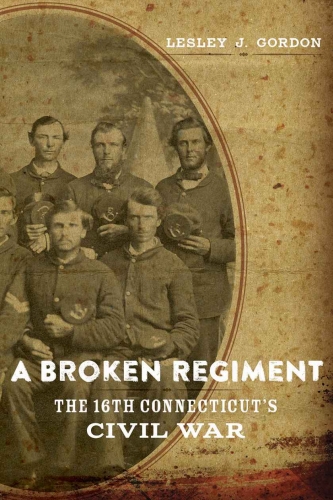
A BROKEN REGIMENT: THE 16TH CONNECTICUT’S CIVIL WAR
(LOUISIANA STATE UNIVERSITY PRESS, 2014)
BY LESLEY J. GORDON
Too often, battle history can take on a triumphalist tone, elevating participants to heroic status and reducing war to glorious charges, stirring drums and trumpets, and banners snapping in the breeze. Lesley J. Gordon’s A Broken Regiment: The 16th Connecticut’s Civil Waris both a refreshing corrective to more celebratory views of battle in the Civil War and a model for modern unit studies. Gordon examines the 16th Connecticut Infantry, a hard-luck outfit recruited in the summer of 1862 and thrown into the Battle of Antietam just a month later. Gordon describes a regiment gutted in its first major combat and fleeing the field, its survivors spending much of the aftermath attempting to live down that engagement. To cap off its humiliating chapter in the war, the 16th Connecticut surrendered in 1864, with many of its members then to languish in Confederate prison camps like Andersonville. Gordon not only takes readers inside the harrowing combat experiences of the regiment, but also follows them to their painful conclusions, in hospitals, prisons, and postwar efforts to come to terms with the war. Not all combat veterans emerged heroes, and Gordon’s book is both deeply researched and holistic in its insights about Civil War combat and its legacies.
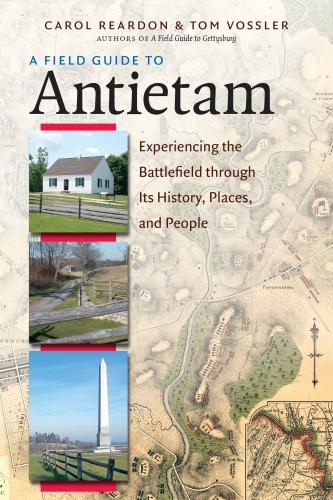
A FIELD GUIDE TO ANTIETAM: EXPERIENCING THE BATTLEFIELD THROUGH ITS HISTORY, PLACES, AND PEOPLE
(UNIVERSITY OF NORTH CAROLINA PRESS, 2016)
BY CAROL REARDON AND TOM VOSSLER
No list of great books about Civil War combat would be complete without a battlefield guide, and Carol Reardon and Tom Vossler’s A Field Guide to Antietam: Experiencing the Battlefield through Its History, Places, and Peopleis one of the finest. Beautifully illustrated with detailed tactical maps and extensive photographs complementing crisp prose, Reardon and Vossler’s study is more than simply a tour guidebook. Readers hoping to understand the ebb and flow of battle, the problems of command and tactics and terrain, weather, logistics, fog of war, and also get an operational history will find A Field Guide to Antietam essential. The authors have years of experience immersed in the complexity and nuance of Gettysburg, Antietam, and other major engagements. Their decision to organize this study along questions like “What happened here?” “Who fought here?” and “How did participants remember the events?” makes the complicated nature of Civil War battles like Antietam both easily understandable and entertaining, even for novices. Their Gettysburg guide is also invaluable and, like this one, should be required reading for anyone wishing to visit or enjoy either site from the comfort of an armchair.
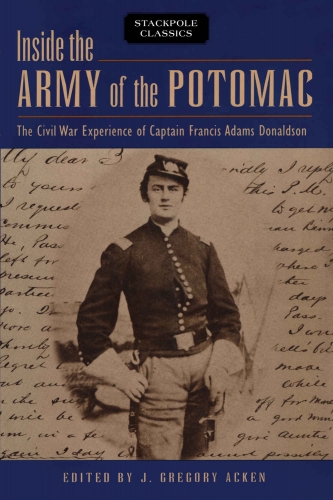
INSIDE THE ARMY OF THE POTOMAC: THE CIVIL WAR EXPERIENCE OF CAPTAIN FRANCIS ADAMS DONALDSON
(STACKPOLE BOOKS, 1998)
ED. BY J. GREGORY ACKEN
A list of books on Civil War combat ought to include a collection of published primary sources, and there are hardly any better than Greg Acken’s edited collection of Captain Francis Adams Donaldson’s wartime papers. Donaldson, a Pennsylvanian who led troops through 1863, wrote extensively about his campaign experience in most of the eastern theater’s major battles, and left behind a treasure trove of detail on the inner workings of a combat regiment, alongside the backbiting, feuding, and politicking within a Civil War army’s command structure. Donaldson’s accounts are unstinting and intense, laying bare the gore and tragedy of Civil War combat in ways few other such primary sources do. Among the many insights to glean from Donaldson’s writings is the near-constant stress that junior and field-grade officers experienced leading their men. From dealing with incompetent and ambitious peers, overweening subordinates, and insubordinate soldiers, as well as surviving the ordeal of combat, Donaldson does not at all sanitize his insider’s view. Acken’s extensive and expert editing provides invaluable clarification throughout.
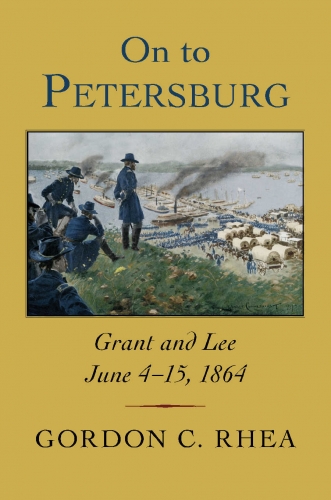
ON TO PETERSBURG: GRANT AND LEE, JUNE 4–15, 1864
(LOUISIANA STATE UNIVERSITY PRESS, 2017)
BY GORDON C. RHEA
We are in a golden age of Civil War operational and campaign studies, and one of the finest to appear recently is the long-awaited conclusion to Gordon Rhea’s five-volume series on the 1864 Overland Campaign. In On to Petersburg: Grant and Lee, June 4–15, 1864, Rhea follows the operations of the Army of the Potomac and the Army of Northern Virginia over a 12-day period, concluding with the start of the siege of Petersburg, Virginia. With a lively and lucid style, Rhea confronts important operational and strategic questions of the Civil War, namely Ulysses S. Grant’s effort to shift the Union focus to the defeat of Robert E. Lee’s army rather than the capture of Richmond, and Lee’s response. Rhea’s gift to students of Civil War combat is his ability to explain complicated and detailed military matters while keeping the pace of his narrative from getting bogged down. In the process, Rhea weaves operational analysis into his tale of front-line combat with great effectiveness.
ANDREW S. BLEDSOE IS AN ASSOCIATE PROFESSOR OF HISTORY AT LEE UNIVERSITY. HE IS THE AUTHOR OF CITIZEN-OFFICERS: THE UNION AND CONFEDERATE VOLUNTEER JUNIOR OFFICER CORPS IN THE AMERICAN CIVIL WAR(LOUISIANA STATE UNIVERSITY PRESS, 2015) AND CO-EDITOR OF UPON THE FIELDS OF BATTLE: ESSAYS ON THE MILITARY HISTORY OF AMERICA’S CIVIL WAR(LOUISIANA STATE UNIVERSITY PRESS, 2018).
This article appeared in the Spring 2020 (Vol. 10, No. 1) issue of The Civil War Monitor.


